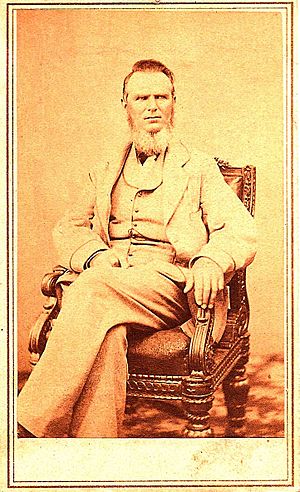Hiram Warner Farnsworth facts for kids
Hiram Warner Farnsworth (born October 13, 1816, died July 26, 1899) was an important leader in Kansas history. He was an abolitionist, meaning he was strongly against slavery. He was also a pioneer who helped settle Kansas, an educator, and a community leader. He played a big part in making Kansas a free state.
Early Life and Moving West
Hiram Warner Farnsworth, often called H.W., grew up in Brattleboro, Vermont. He went to Williams College and finished his studies in 1840. After college, he taught school in Alabama and then became a principal at a school in New London, Connecticut.
In 1842, H.W. married Deborah (Della) Torrey Lerow. She was also a teacher. They had three children, but one sadly passed away when he was very young. Della died in 1850. A few years later, in 1855, H.W. married his second wife, Harriet Ann Stoddard.
During the 1850s, H.W. became very involved in the discussions about slavery. He was a Congregationalist and believed slavery was wrong. He decided to take action, inspired by the New England Emigrant Aid Company. This company helped families who were against slavery move to Kansas. Their goal was to make sure Kansas would become a free state, not a slave state.
In March 1856, H.W. and his new wife, who was expecting a baby, and his two young daughters began their long wagon journey to Kansas. It took them six weeks to travel across the country.
A Kansas Pioneer
On May 9, 1856, H.W. and his family arrived in Lawrence, in the Kansas Territory. However, they soon realized Lawrence wasn't the right place for them. So, they moved on to Topeka, Kansas, arriving on May 16, 1856. Topeka had been started in 1854 as a "Free-State" town, meaning it was against slavery.
One of H.W.'s first actions in Topeka was to buy a farm. He also helped start the Topeka Mill Co., which was a mill for sawing wood and grinding grain. On July 14, 1856, H.W. helped found the First Free Congregational Church of Topeka. He became one of its first deacons.
H.W. quickly became a leader in the community. In 1859, he was elected to the first Territorial Senate of Kansas, before it became a state. He represented Shawnee County as a Republican. The next year, he was elected as the fourth mayor of Topeka. After a lot of debate and struggle, Kansas officially joined the United States as a free state on January 29, 1861.
In May 1861, H.W. left the Kansas Senate to take on a new role. President Abraham Lincoln appointed him as an agent for the Kaw Indians in Morris County, near Council Grove, Kansas. His job was to work with the Kaw people. Joseph James, a mixed-blood Kaw Indian, helped H.W. as an interpreter.
H.W. also became an Indian Commissioner in 1864, appointed by President Lincoln. He was responsible for negotiating treaties between the United States and various Indian tribes. In 1868, a small fight happened between the Cheyenne and Kaw Indians near the Council Grove Indian Agency. It was noisy but no one was hurt, and it was the last Indian battle in Kansas. The Farnsworth family watched from their home at the agency.
H.W. was also involved in building Kansas's future. He became one of the first directors for the Atchison & Topeka Railroad in 1863. Because of his background in education, H.W. was a founder of Washburn College, which started in 1865. He served on the college's board of trustees for twenty years.
In 1867, H.W. traveled to Washington, D.C., with Indian tribal leaders to sign treaties. His Kaw Indian interpreter, Joe Jim, was with him. It was common for Indian agents to be photographed with the chiefs, but H.W. refused. He felt that the Native Americans were being cheated out of their lands, and he didn't want to be part of something he felt was unfair. Joe Jim, his interpreter, is actually credited with giving the name Topeka to the town!
Later Years in Topeka
In May 1867, H.W. and his family moved back to Topeka. By this time, he had seven children. On May 21, 1867, Topeka citizens voted to create a Board of Education, and H.W. was elected to this first board.
H.W. continued to support important causes. In September 1867, he signed a petition in Kansas that supported voting rights for women and black people. He was one of 45 people in Kansas to sign it. From 1869 to 1873, H.W. served as the postmaster of Topeka.
He also helped establish the Free Public Library of Topeka in 1878. H.W. was one of its founders. He was also a member of the Association of Old Settlers of Topeka because he had arrived so early in 1856.
H.W.'s second wife, Harriet, died in 1894. H.W. himself passed away on July 26, 1899, at his home in Topeka. He was buried in the Topeka Cemetery next to Harriet.
Family
- H.W. married Deborah (Della) Torrey Lerow in Boston, Massachusetts, on March 17, 1842.
They had 3 children:
-
- Kate Leland (1843-1930)
- Mary Emma "Minnie" (1845-1927)
- Oliver Dimon (1847-1848)
Della died on June 5, 1850.
- H.W. married Harriet Ann Stoddard in New London, Connecticut, on December 3, 1855.
They had 5 children:
-
- William Seymour Epaphroditus (1856-1930)
- Adeline Lurena "Addie" (1858-1938)
- James Watson Brown (1860-1940)
- Coit Learned (1863-1936)
- Fred Colfax (1866-1945)
See also


